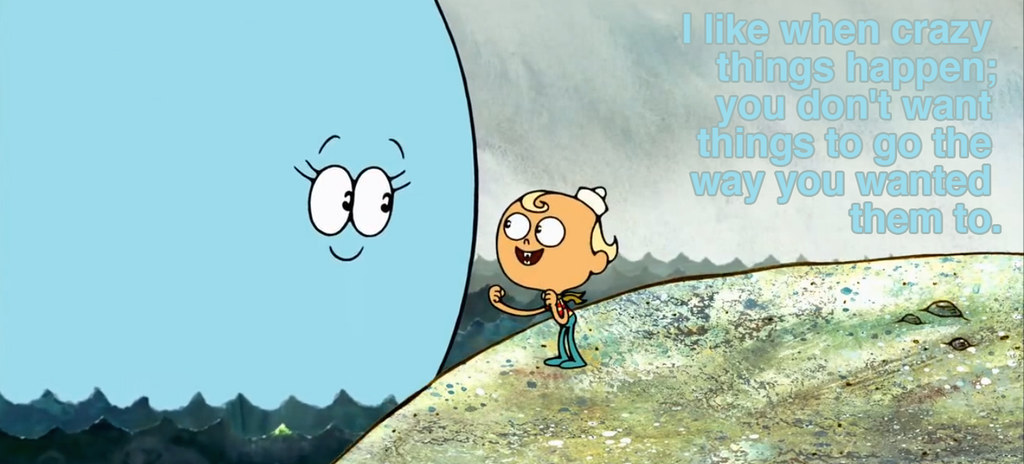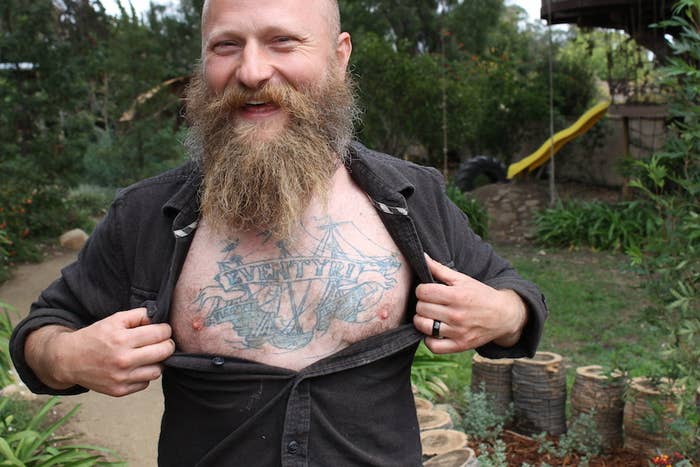
Thurop Van Orman sat on a stump. Speaking through his long, reddish beard in his garden, he described Cartoon Network's reception of the animated Marvelous Misadventures of Flapjack — the children's show he created that ran from 2008 to 2010 about the eponymous naïve boy whose best friend is a washed-up captain who gets drunk on maple syrup. Both main characters live in the mouth of a whale, hate vegetables, and eat nothing but candy. Before its premiere, Stu Snyder, who'd just taken over Time Warner's Turner Animation unit in mid-2007, laid out a new set of rules for kids' shows.
"'We don't want anything weird or anything where any mom would come out of the kitchen and say, 'What are you watching?'" Van Orman remembered Snyder saying. Snyder also recalled this guideline, although he said he supported Flapjack "from day one," while another source from Cartoon Network also remembered tension in Snyder's early days. Since one of the earliest episodes of the weird show greenlit by Snyder's predecessor has Flapjack and Captain K'nuckles racing a terrifying mechanical shark through the "Sea of Teeth," Van Orman's response to Snyder's dictum was, "It's a little late for that."
Network executives quickly warmed up to Flapjack, which Snyder described as "a charming, nice show," after it premiered and viewers connected with the bizarre fictional Stormalong Harbor and its often degenerate denizens. Roz Ryan, the voice of the big blue whale in whose mouth Flapjack lived, said she gets more fan mail for Bubbie the motherly cetacean than for any character she's ever played. After that initial bump, Snyder and Co. fostered Van Orman's fun factory. "Cartoon Network, especially at that time, was like, Wild West, and I could do anything that I wanted to," Van Orman said. "Not that I didn't get any resistance to the stuff that I wanted to do, but they were open to experimentation."
With Flapjack, Van Orman and his storyboard crew were their own target audience. "It was, like, a bunch of buddies making stuff that made each other laugh," he said as he stroked his beard.
"We were funny to him," said Pendleton Ward, a writer and storyboard artist on Flapjack who was only vaguely aware of the conflict with executives. He described the Flapjack offices as "carefree," adding the writers and artists lived by Van Orman's motto: "This is the fun factory!" "I learned that from Thurop, how to create a fun factory," said Ward, who went on to conceive the Cartoon Network cult hit Adventure Time. "You're having conversations more, and not dictating things."
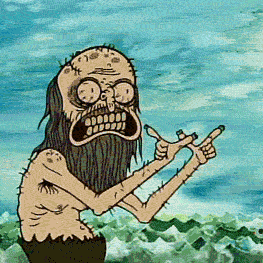


The Westman hisses "wessssssst" in Flapjack's "How the West Was Fun."
Flapjack ended in part because three of its artists went off to make their own oddball cartoons: J.G. Quintel created The Regular Show, Alex Hirsch created the Disney Channel's Gravity Falls, while Ward launched Adventure Time with Flapjack artist Patrick McHale in tow; shortly thereafter, Ward hired his former boss as a showrunner, a position he held until 2011.
Van Orman has worked steadily since the end of Flapjack, often with alumni of his show — after Adventure Time, he worked as a supervising producer on Nickelodeon's Sanjay and Craig, and now voices the devious Li'l Gideon on Hirsch's Gravity Falls.
His near-compulsion to break the rules is what distinguishes him, said Bryan Mann, the animator he plucked from the verge of homelessness when he gave him a job as a storyboard artist on Sanjay and Craig. "Usually in animation, you see the sassy girl character, and here's this character that you've seen before," Mann explained. "With Thurop's characters, they're always really genuine people that you've probably met but never really gotten to know because they're kinda weird."
Mann matter-of-factly noted that Van Orman also liked to wrestle his co-workers in the office. "One day I wrestled him, and then he was like, 'I want you to work in animatics with us," he remembered with a chuckle. (He credits his promotion from storyboard artist to storyboard director largely to Van Orman's stewardship.) According to Mann, you can do no wrong working in "the fun factory" under Van Orman's failure-friendly refrain: "Just try it and see what happens."
Despite that motto and the fact that he was working on other projects, the end of Flapjack prompted a mild artistic crisis for Van Orman. "I was like, This is the show that I always wanted to make," he said. "What do I do now?" Flapjack trawled through Van Orman's lifelong love of the sea: He has had at least two harebrained youthful schemes to escape via jury-rigged rafts; a whale weathervane shifts over his garden; and he has a ship tattooed on his chest with the word "EVENTYR!" — Danish for "adventure" — inked over it. The ocean is quite literally near his heart. And then, in a grand callback to a childhood spent between the sea and the woods, he found the next step: forest adventures.
"I've done sea adventures, and now I want forest adventures."
After his realization, Van Orman started working on a movie called Black Forest in 2011 as well as its related TV show, North Woods. Both center on the masked heroine Robin, who's based on his 6-year-old daughter, Hazel, and his wife, Sherri.
"The feature world really looks down on TV," Van Orman said. "I felt like when I left Cartoon Network, I could've done a TV show anywhere, and I guess I assumed that that was gonna be the case for movies too. But it sure wasn't. So, I worked really hard on it for a year and a half, and realized it wasn't gonna happen."
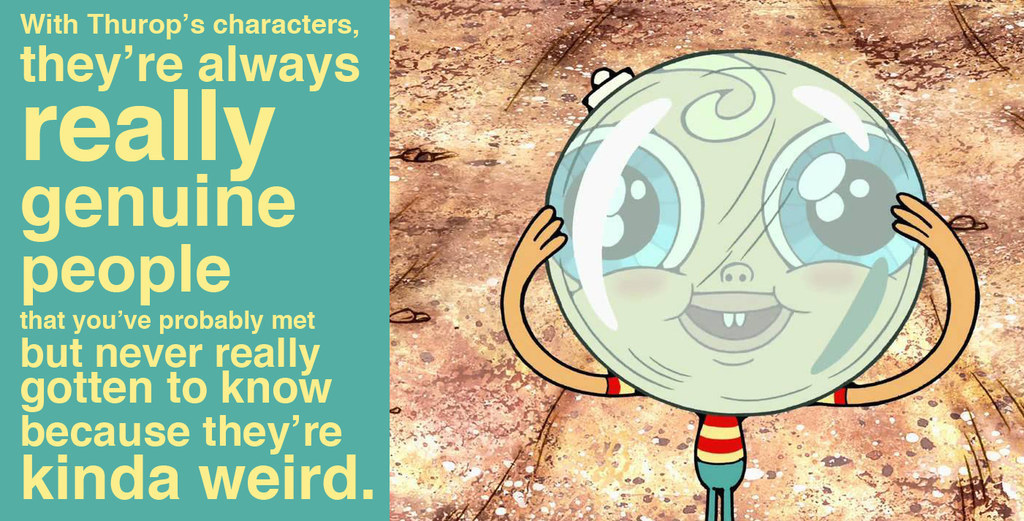
Instrumental in persevering with the project is his partner, Ryan Crego. In addition to collaborating on Black Forest, which is still in development, and North Woods, they're working on a semi-secret project for Sony.
"He's all unkempt and looks like a homeless man, and I've got my cardigan on," Crego said of Van Orman, though both noted their contrast is the key to their partnership. "How could he possibly even hold down a job, you know what I mean?" Sometimes, Crego said, he feels like a "stick in the mud" by comparison.
Indeed, Van Orman gives off the air of mischief befitting a boisterous storyteller, and after our second interview, he sent me an email that said, "I also have stories about being pulled into alleys by Mexican gangs at gunpoint, accidentally hopping trains with two rival gangs, sleeping in abandoned luxury hotels with iguanas climbing in and out of the walls, but you probably have too many stories from me as it is..." Attached to the email was a photo of him as a child in the forest.
That blond, beardless, barefoot boy, swinging on a vine through palm fronds has informed Van Orman's work: Flapjack's ever-cheerful protagonist and his older, crankier partner in derring-do, Captain K'nuckles, were based on the young and the adult Van Orman, respectively; the blond little boy version of himself was named after a dream he had as a teenager in which he was called Captain Flapjack. "I flew a flying motorcycle through the sky and I had these big rubber boots," he recalled, adding that he was "really shitty at flying."
His mother, Ellen Van Orman, said a particular Season 1 episode, "Diamonds in the Stuff (Down the Drain)," was near-autobiography: When her youngest son was around 8 or 9, he climbed into a gutter grate to look for diamonds. "He was always getting into some sort of mischief," she said.

Van Orman's wanderlust set in after his family's move from the Florida Panhandle to Salt Lake City, Utah. Then 13, he was excited, but it wasn't what he'd hoped for. "In my imagination, I get myself psyched up for the best version of something, and then it was not the best version," Van Orman said. He got a job as a janitor and earned enough money to buy a ticket back to Panama City. "My plan was to run away and live on Shell Island for I don't know how long. Make my way in the world."
He'd read books about sailors who "leave home when they're 12, and I was 13, so I felt like I was really old, and I felt like I could totally do it," he said, setting up the same story he'd told his daughter at bedtime the night before. As a kid, he thought as long as he prayed, went to church, and read scripture, "God's totally got my back." (Van Orman's attitude would change later during a teenage mission trip to Paraguay, where he spent 10 months trying to give himself a blood infection or break his leg so he'd get sent home; he eventually broke his leg accidentally, during a soccer game.)
The rest of his Shell Island story is marvelous enough to be its own cartoon: He told his parents about his plan, and they told him he could not go the chosen small, undeveloped barrier island between the bay and the Gulf of Mexico, but he could go to Panama City and stay with a Mormon family there.
But, "when he got an adventure in his head, there was no stopping that," his mother said.
Once in Florida, before he went to Shell Island, he met a homeless man by the railroad tracks. "I gave him all of my money, and then I was like, All right, well this is it. Now I gotta go."
Later, under the cover of darkness, he paddled toward the island in a stolen boat; his handmade paddle quickly fell apart. He panicked, paddling with his hands, "just waiting for any minute, a shark to bite my hands off." He made his way back to shore and waited until morning.
"This is where I get my stories mixed up, because at one point, I paddled across on my surfboard, and at one point, I paddled across on that same boat," he said. After referencing his old journals, Van Orman confirmed that he went to Shell Island twice that summer, and again the summer that followed. His plan was to go "super back to basics," so he brought no food, no water, and no knife. The island, he said, was filled with rattlesnakes.
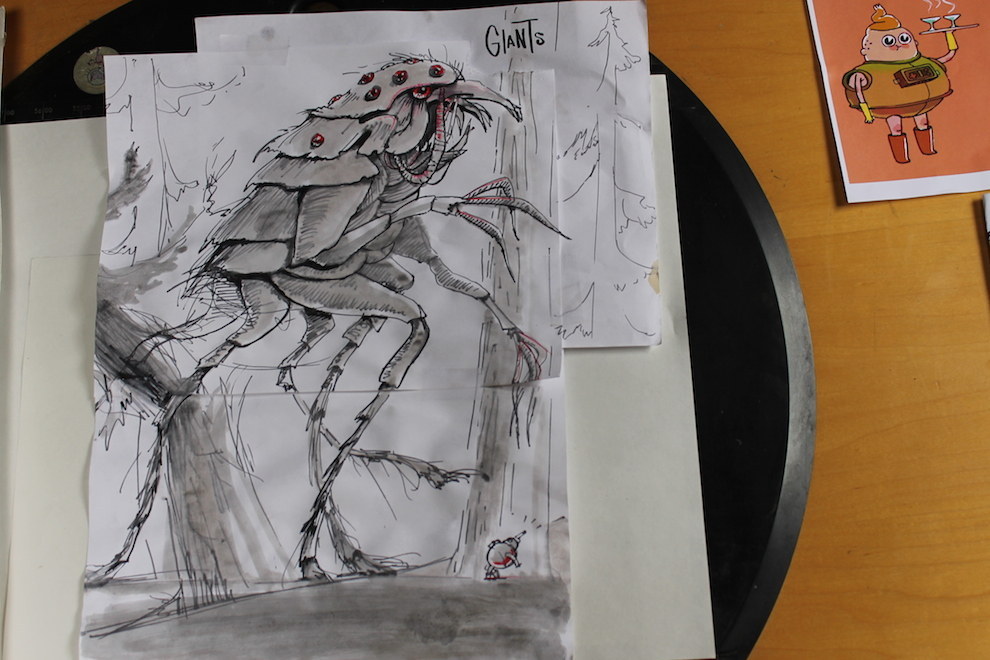
Without a tent, he made his way to the interior of the island, headed for a marshy area he thought the rattlesnakes would avoid. Building his hut, he saw an alligator, and threw a branch at the reptile. "It went underwater, and I was like, Well, now the alligator's mad at me and he's gonna try to eat me the whole time. So I was like, I don't know where to sleep now because I'm gonna get eaten by an alligator, or I'm gonna get bit by rattlesnakes."
He ended up sleeping on the beach that night. The next day, he attempted to eat a raw sea urchin, and, when that failed, he speared a ray in the sea and cut it open.
"I'd gutted a fish before, but this was nothin' like a normal fish," he said. "It looked like an alien and it wouldn't stop breathing." Shortly thereafter, Van Orman became a vegetarian. "It was horrifying. And so I just couldn't do it anymore, and I buried it, and slept on the beach, wrapped in a sheet because I didn't bring a blanket, totally sunburned, freezing my ass off, and I just didn't sleep all night."
Disheartened, Van Orman hitched a ride back to shore and spent the rest of the summer working and living with his parents' Mormon friends. When he got home and friends asked him about his grand adventure, he told them a story of failure.
But he had an epiphany: "No one wants to hear that you lived off the land and you did it all — what you set out to do," he said. "They wanna hear everything that happens instead. It had a pretty big effect on me, just realizing, like, Oh my gosh! That was the adventure! I did have an adventure! For the rest of my life — the next summer, I ran away and lived in Mexico, and the crazier things got, the more I was like, Yeah, this is it!" (That summer in Mexico, he said, was a failed trip to the jungle; he got sick and ended up living with a Mormon family in Puerto Vallarta, a freshly minted vegetarian marveling at "eye tacos.")
And that's how Van Thurmon's fun factory became a place to "just try it and see what happens." "For better or for worse, I think that's influenced who I am a lot, because I like when crazy things happen," he said. "You don't want things to go the way you wanted them to."
The Shell Island adventure sounds like the improbable stuff great bedtime stories are made of, but an employee at Visit Shell Island confirmed that there were rattlesnakes on the island, and a representative from the Panama City Beach Visitors Bureau said that Shell Island is indeed uninhabited, although day-tripper tourism has picked up in recent years. He also confirmed the presence of an alligator in one of the lagoons on the interior, although you wouldn't get there on foot, he said, not if you were "a normal person."
